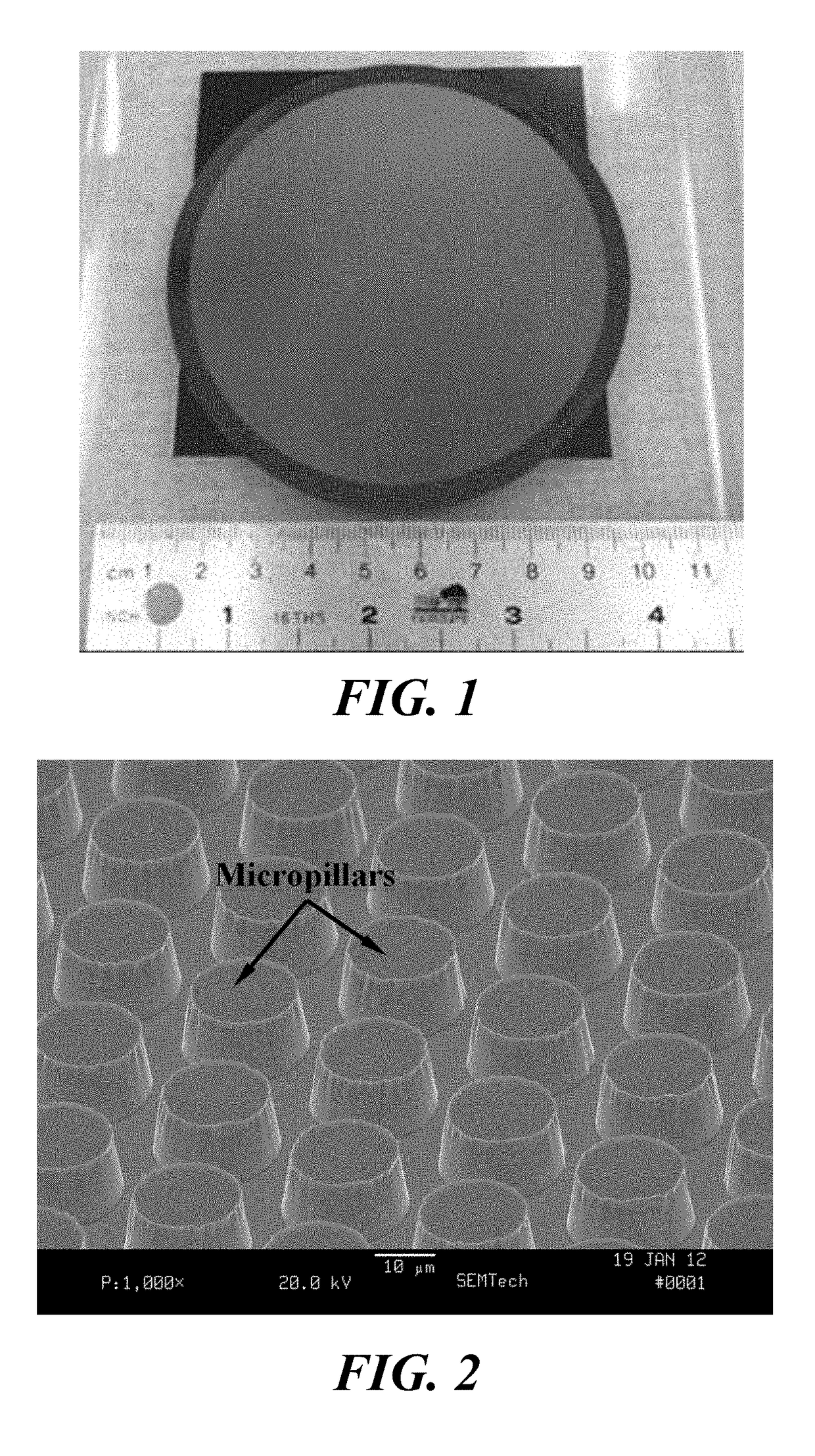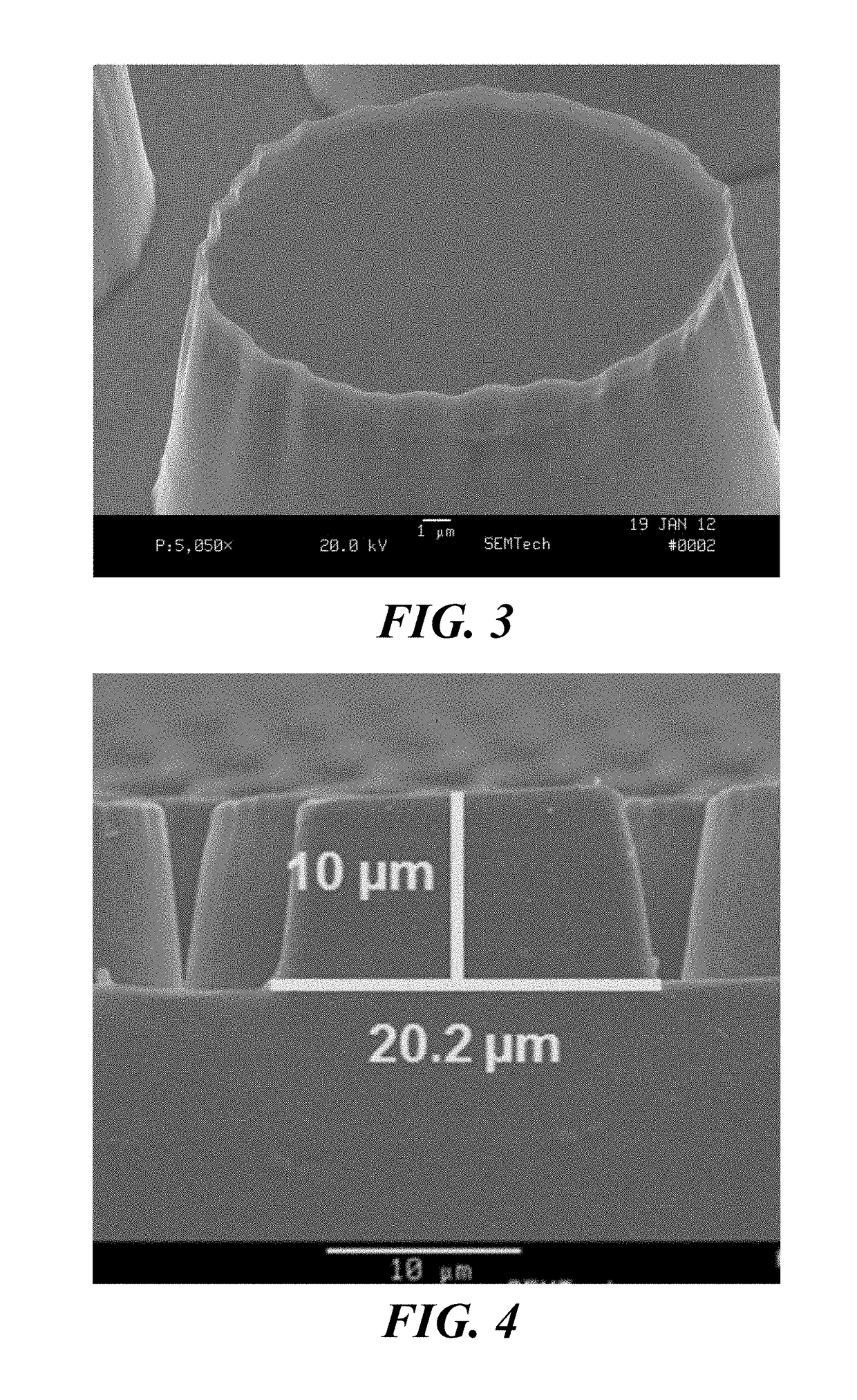Micromold methods for fabricating perforated substrates and for preparing solid polymer electrolyte composite membranes
a technology of perforated substrates and micromolds, which is applied in the direction of cell components, final product manufacturing, sustainable manufacturing/processing, etc., can solve the problems of low porosity, brittleness, and affecting the performance of fuel cell and electrolyte,
- Summary
- Abstract
- Description
- Claims
- Application Information
AI Technical Summary
Problems solved by technology
Method used
Image
Examples
examples 1 and 2
Thermal Perforation of Polysulfone Using Micromolds with Square and Round Micropillars
[0113]To provide a desired perforated pattern on a substrate, nickel micropillars on a nickel micromold were created using photolithographic development (i.e., using photoresists and 2D masks) followed by electroplating replication. In these two examples, the shapes of the micropillars created on the micromold were square and round. For both cases using micromolds with square micropillars and round micropillars, a thin film of polysulfone (PSU) was deposited on the carrier (PET or polyimide). In both cases, the PSU layer comprised the substrate layer. Once the PSU layer was deposited, the nickel micromold was pressed against the PSU layer at a pressure between 300-500 psi. The temperature of the system was then increased from ambient temperature to a peak temperature above the glass transition temperature of PSU, held at the peak temperature for approximately 5 minutes, and then the temperature was...
example 3
tion of UV-Curable Perforation of Polysulfone Using Micromolds
[0115]The same method for creating the micromolds used in Examples 1 and 2 was used to create the micromolds with round micropillars for this UV-curable example. A UV-curable liquid monomer solution comprising acrylate liquid monomer (i.e. 1-Hydroxy-cyclohexyl-phenyl-ketone) with ˜2% initiator [i.e. Phenylbis(2,4,6-trimethylbenzoyl)-phosphine oxide)], was blade-coated onto a MYLAR® stretched PET carrier layer. Next, the micromold was pressed against the UV-curable liquid monomer solution (at 150 psi), and UV light (350 nm wavelength) was focused on the UV-curable liquid monomer solution for one minute to form the polymer electrolyte membrane substrate (i.e. poly-1-Hydroxy-cyclohexyl-phenyl-ketone). FIG. 22 shows the resulting perforated substrate (10 um thickness, 20 um dia. holes) on the MYLAR® stretched PET carrier layer.
example 4
tion of Solvent-Based Perforation of Polysulfone Using Micromolds
[0116]The same method for creating the micromolds used in Examples 1-3 was used to create a micromold with round micropillars for this solvent-based example. First, a polymer solution consisting of 30% by weight of PSU dissolved in N-methyl pyrrolidone (NMP) was bar coated over the surface of the micromold to fill the voids between the micropillars of the micromold. The micromold was then placed in an inversion solvent bath (in this case, the inversion solvent was water), and the PSU precipitated out of the polymer solution leaving a perforated PSU film on the micromold. FIG. 23 shows an SEM micrograph of the resulting perforated 6.8 μm thick PSU film.
PUM
| Property | Measurement | Unit |
|---|---|---|
| diameter | aaaaa | aaaaa |
| height | aaaaa | aaaaa |
| thickness | aaaaa | aaaaa |
Abstract
Description
Claims
Application Information
 Login to View More
Login to View More - R&D
- Intellectual Property
- Life Sciences
- Materials
- Tech Scout
- Unparalleled Data Quality
- Higher Quality Content
- 60% Fewer Hallucinations
Browse by: Latest US Patents, China's latest patents, Technical Efficacy Thesaurus, Application Domain, Technology Topic, Popular Technical Reports.
© 2025 PatSnap. All rights reserved.Legal|Privacy policy|Modern Slavery Act Transparency Statement|Sitemap|About US| Contact US: help@patsnap.com



